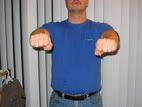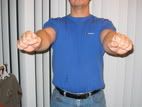Squat (high bar)
Squat (low bar)
Squat (w. Manta-Ray)
Squat (w. Top Squat)
Squat (goblet)
Squat (Jefferson)
Squat (Hack)
Squat (Zercher)
Squat (trap bar)
Squat (cambered bar)
Squat (safety squat bar)
Squat (thick bar)
Squat (w. hip belt)
Squat (front)
Squat (front + push-press/"thruster"/"long press")
Squat (overhead)
Squat (full)
Squat (half/parallel)
Squat (quarter)
Squat (walk-outs)
Squat (regular stance)
Squat (narrow stance)
Squat (wide stance)
Squat (ultra-wide stance)
Squat (w. chains)
Squat (w. bands)
Squat (w. weight releasers)
Squat (box)
Squat (low box)
Squat (high box)
Squat (pause)
Squat (eccentric-only)
Squat (concentric-only)
Squat (isometric)
Squat (oscillating)
Squat (breathing)
Squat (fast tempo)
Squat (slow tempo)
Squat (varied tempo)
Squat (bodyweight)
Squat (face wall)
Squat (Hindu)
Squat (one-legged)
Squat (pistol)
Squat (Bulgarian split)
Squat (split)
Squat (lunge)
Squat (side-lunge/"Cossacks")
Squat (bearhug w. sandbag)
Squat (shouldered sandbag)
Squat (front w. kettlebells)
Squat (front w. single kettlebell)
Squat (overhead w. kettlebells)
Squat (one-arm overhead)
Squat (drop to overhead)
Friday, July 29, 2011
Wednesday, July 27, 2011
Training As Escape - When Habit Becomes Addiction
...a book I've never read
(Does he look like an exercise junky to you?)
The discipline of regular training has always been a time to catch my breath and clear the mind, a "fortress of solitude" so to speak. In this way, time in the gym can be like a steam valve - a healthy outlet for the body and mind to reset.(Does he look like an exercise junky to you?)
BUT, for many of the most dedicated gym-rats, training can become more than a healthy habit. You see it a lot in gyms, bootcamps, and affiliates: the training addict. They use physical exercise as a way to escape loneliness and emotional chaos. They use a combination of endorphins and subsequent fatigue to keep their thoughts and emotions in check. Training becomes an obsession in AND out of the gym... marathon gym sessions, conversations on and off-line about exercise, programming, and tools, tools, tools. And here's the kicker: ALL OF THIS WORKS... for a while... until you need more (and addicts will always need more)... until you can't train... until it doesn't. Believe it or not, the SAID (specific adaptations to imposed demands) principle applies here as well; if you lift weights to forget your problems, you get better at lifting weights to forget your problems. Unfortunately, the problems do not dissappear and your other strategies and means to deal with and eliminate stress may atrophy.
Sadly, all of the training logs, food logs, pedometers, heart monitors, magazines, forums, blogs, journals, and body bugs in the world will not fill the psychic void, nor unroot the underlying anger and sadness. None of these address the core issues and is the equivalent of someone putting a lid that is too small on a garbage can of fermenting thought patterns.
There is no easy solution. Yes, weight training can be just the catalyst to turn your entire life around, but it can just as easily become another avoidance strategy. I've seen a lot of both. When exercise becomes a substitute for dealing with life issues, those issues may simply wait it out and come knocking again when you least expect it and are least able to deal with them. They want and need your attention.
Related Posts:
Redemption Center Diaries (Squat Rx blog post)
Managing Depression With Weightlifting. Or, How You Feel Is A Lie (Nick Horton's blog post)
Doing Nothing (Squat Rx blog post about meditation)
Friday, July 22, 2011
Strength Work and Technique Work Are NOT Mutually Exclusive
I used to get at least a couple of emails every week from someone who wanted to improve their squat numbers and their squatting technique. Usually, the email would read something like this:
My canned response would usually be something like this:
I think there is great value in spending time with the empty bar, or even a broomstick for some movements, but here's the thing: you can easily chew up a few months to a year doing nothing but corrective drills and empty bar work, only to find other issues waiting for you when you finally decide it's okay to add weight. Yes, a lot of people need to "work on technique" (and I define technique broadly to include the bar path, inter/intra-muscular coordination, proprioception, range of motion, tempo, etc), but that must not be exclusive of heavy work if your goals include lifting heavy weights. So, at what point is the weight heavy enough? It depends on the exercise and the individual, of course, but for squats, 60% of your one-rep-max for multiple low rep sets is a good starting point. As a general rule, beginners will have greater tolerance to handle higher percentages and volume, while more advanced lifters may use even lower percentages and at times with additional resistance in the form of bands or chains.
Hi,
Thank you for your Squat Rx videos. I've learned a lot from them. I realize now that I am flexing my lower back as I lower into my squat and I'm not really engaging my glutes or hamstrings at all. My thoracic spine mobility stinks and so does my hamstring flexibility. I have bad posture to boot. I can squat 225lbs x 5 x 5, but I'm going to start squatting only the empty bar until I get my technique right. What do you think? Any advice you could give would be awesome. Thanks.
My canned response would usually be something like this:
Hi,
Thank you for the kind words about the videos. I'm glad you found them informative.
I think that relying on empty bar work is going to be a mistake if you are hoping to bring up your squat numbers as well as technique. My suggestion would be to back off on the weights a little for a few weeks and strive to make every rep as rock-solid as you can. Concentrate on ONE THING (and only one) to improve on with your squat in a given session and make sure you "git'r done". Good luck and let me know how it goes.
I think there is great value in spending time with the empty bar, or even a broomstick for some movements, but here's the thing: you can easily chew up a few months to a year doing nothing but corrective drills and empty bar work, only to find other issues waiting for you when you finally decide it's okay to add weight. Yes, a lot of people need to "work on technique" (and I define technique broadly to include the bar path, inter/intra-muscular coordination, proprioception, range of motion, tempo, etc), but that must not be exclusive of heavy work if your goals include lifting heavy weights. So, at what point is the weight heavy enough? It depends on the exercise and the individual, of course, but for squats, 60% of your one-rep-max for multiple low rep sets is a good starting point. As a general rule, beginners will have greater tolerance to handle higher percentages and volume, while more advanced lifters may use even lower percentages and at times with additional resistance in the form of bands or chains.
Sunday, July 17, 2011
Dan John's "Intervention" - DVD Review
Yes, it's great.
"Intervention" - 3 DVD Set ($129)
The newest DVD from Dan John is his best work to date. In my opinion, it is an absolute must-have for trainers and S&C coaches. I know I've probably said that before about other products and I stand by those, but it is that superb. How does this DVD differ from his others? This one is all about programming - creating an appropriate strength program for you and your clients, whether they are sedentary baby boomers, age groupers, or elite athletes. He runs down just about everything you need, from "assessments", to rep schemes, to exercise selection.
There are three DVDs in the set, each running about an hour. The first disc is good - very "Dan John". The second disc, I thought "Whoa... I need to pay better attention." The third disc had me fumbling for the pause button so that I could grab a pen and crack open a notebook to catch up.
Dan begins with a run down of some basic tools to bring to bear when you first work with a client, then moves to basic human movements, then follows with "patterns", "slow strength", "symmetry", and "the triads" (sounds ominous, I know). The DVD does a great job of split-screen displaying Dan John's notes in a digital format that's easy to read - you'll appreciate it if you have aging eyes like mine! Having said that, I should be clear that Dan John has really done an amazing job of presenting his material in a very slick table/graphic organizer - I rewrote it in my notes and mulled it over for some time with a smile on my face.
In addition to the video content, the DVDs contain a PDF of the lecture transcript and expanded thoughts (which I have not viewed yet), and also an MP3 audio file that you might listen to in the car, or (like me) while working.
It is more expensive than other products from Dan John and the Drapers, but no Dan John fan would feel it wasn't worth it, and any strength and conditioning coach with a clue will reap huge dividends from the purchase. If you are a training novice, then this DVD set will probably be (no offense intended) over your head and you would do better to start with other DVDs that cover exercise execution, such as Dan John: Perfecting Your Kettlebell Form, or Dan John: Olympic Lifting For Beginners.
The real test of whether the product has an impact is whether or not I will be making changes to my own training because of it... YES. Yes, I will. It is just the push I needed at the perfect time (currently a "yellow", but soon to be a "green"). So, a big thanks to Dan John and the Drapers for putting out something very special.
YouTube clips from Intervention:
Monday, July 11, 2011
A Tip For Pressing
One tip I learned from powerlifting was to keep the "elbows tucked" when bench pressing. Another tip, learned from a world-class powerlifter and bench press specialist in Japan (which I saw again in Pavel Tsatsouline's "The Naked Warrior"), was to drive the shoulders toward the feet while pressing. In Squat Rx #22, I gave the tip to "Do The Fonzie".
All of these tips, functionally, serve to externally rotate the arm, and engage the lats and triceps into your press and support the extended arm, and can be simplified to the instruction to bend the bar in an upside-down "U" while pressing. It isn't something that anyone should over-apply - for many, a resultant pressure on the outside of the palms is enough to engage the lats and tris. It works for both bench and overhead presses, and is more easily learned with a barbell than dumbbells or kettlebells.


"Bend The Bar"
All of these tips, functionally, serve to externally rotate the arm, and engage the lats and triceps into your press and support the extended arm, and can be simplified to the instruction to bend the bar in an upside-down "U" while pressing. It isn't something that anyone should over-apply - for many, a resultant pressure on the outside of the palms is enough to engage the lats and tris. It works for both bench and overhead presses, and is more easily learned with a barbell than dumbbells or kettlebells.


Friday, July 8, 2011
No Frills and No Excuses
I spent some time in Japan this summer and, while my in-law's car port is "enough" (2009 blog post), I wanted to be able to return from Japan ready to squat a little heavier than when I was doing the volume binge of one million pounds. So, I managed to find a weightlifting gym.
I don't think most of these men would know a glute-ham bench from an extra-terrestrial...
There were no frills at this one - an assorted mish-mash of plates, barbells old and worn to the point of having no discernable knurling, an early Universal station that probably predates my birth, a power-rack prototype that doubles as a chinning bar, and a few plate loaded dumbbells that collect dust. There's no music, no air-conditioning, no heating, (when I was there) no women, and (as far as I could tell) no collars. A little better than the pipes and cogs gym perhaps, but nothing extra here.
Gym hours: Monday, Wednesday, Friday, 6pm to 9pm.
Cost: about $100 a year.
Active Members: 20-30.


A high-tech chalk box
So, the question is, how does your gym stack up? If it has everything you need to get strong (and no one needs much really), are you exploiting those resources the best that you can?
Monday, July 4, 2011
Be The Squirrel (Part II)
A few years ago now, I posted about the idea of "mushin" and told readers to "Be The Squirrel". On the same subject, but for clarification, I share with you this video:
Just so it's clear, "being the squirrel" does NOT mean doing what the squirrel does - it is having a "performance mindset", separate and distinct from a "training mindset". The training mindset is reflective, analytical; the performance mindset is not - it is your "go gear". To be successful long-term, you need both.
Just so it's clear, "being the squirrel" does NOT mean doing what the squirrel does - it is having a "performance mindset", separate and distinct from a "training mindset". The training mindset is reflective, analytical; the performance mindset is not - it is your "go gear". To be successful long-term, you need both.
Saturday, July 2, 2011
Huge News - We're Fat Because We Eat Too Much!
Shocking, I know: Scientists Learn That We're Fat From Eating Too Much
I'm glad we have studies like this to tell us the obvious. I mean, really, do we need a longitudinal study to tell us that we are fatter today because we are eating more than we were 30 years ago? The why is irrelevant, but I think it's safe to say that we have more snack foods than ever and, thanks to a lot more computer and desk time, we have more time and access to said snack foods.
I've said this before, but I'll say it again: Sitting more = Eating more. Sitting less = Eating Less.
Often, we eat because we are bored. Channel and web-surfing are boring activities, and we break up the monotony by snacking.
Want to lose weight? Get off your duff!
In the not so distant future, we're going to be like the humans in WALL-E
Subscribe to:
Posts (Atom)












